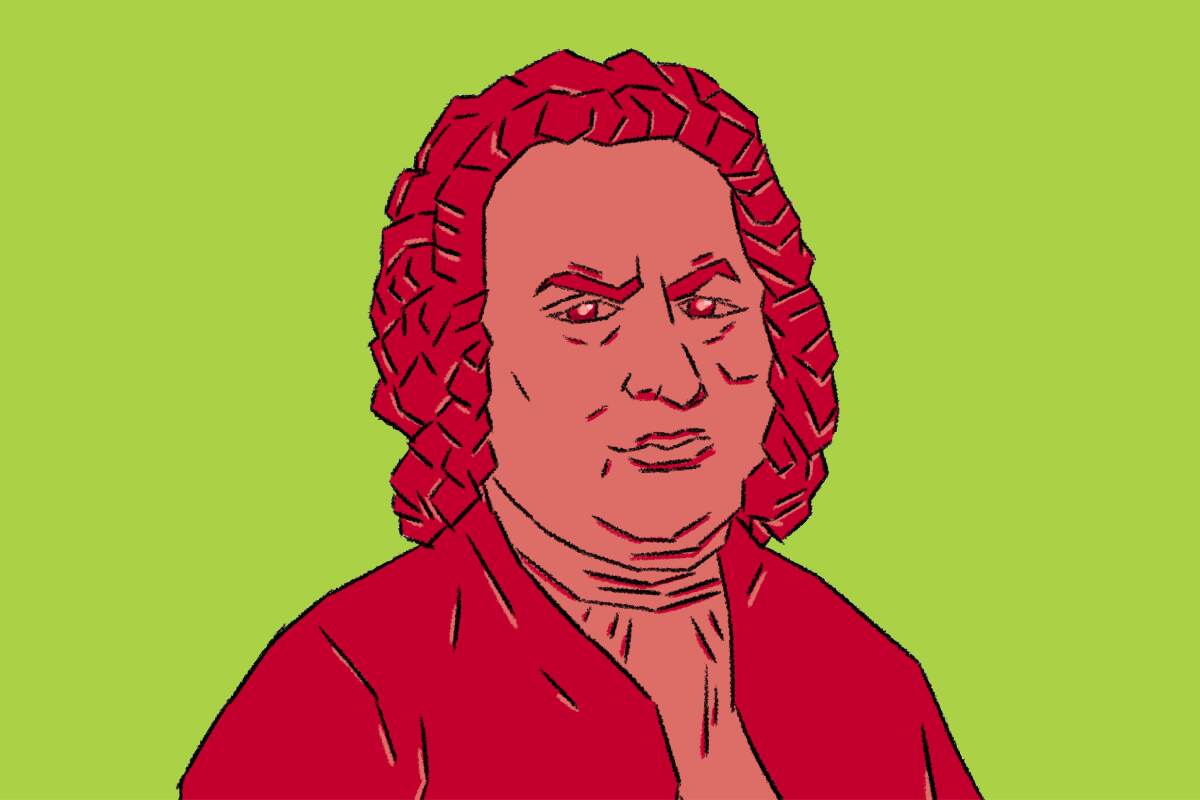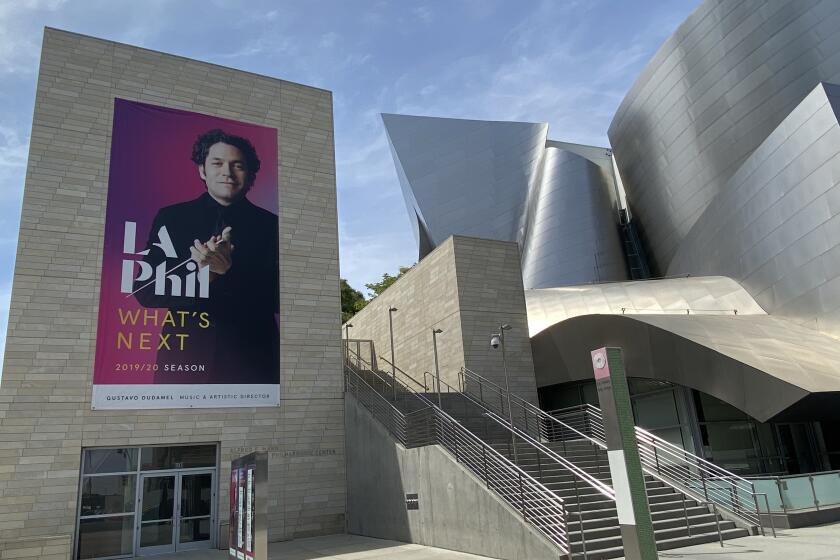Bach wrote BWV 82 to transcend tragedy. It’s a lullaby for our times too

- Share via
“Ich habe genug,” Bach’s Cantata No. 82, is commonly rendered in English as “I am content.” At the cantata’s center is a lullaby of consoling sweetness, generosity of spirit and somnolent blessedness, its melody beyond compare.
These last four months Bach has been classical music’s No. 1 comfort-giver, music bestowing a sourdough for the soul. But who, in their right mind, is currently content? Who’s not sleeping either too much or too little, with nights spent if not in escape then in angst?
The literal translation is “I have enough.” Contentment, on the other hand, presupposes happiness. Bach has something more subversive in mind: not content but shocking content. His cantata provides a manual for how to die sublimely, mapping the road to paradise. And on the surface, this is seemingly the last thing anybody wants to hear during terrifying circumstances that permit no such thing.
I tried an experiment. For a couple of days, the cantata was the last music I listened to before going to bed and the first I turned to in the morning. It neither alleviated nighttime apprehension nor proved effective daytime mood enhancer. I was no more content, but the funny thing was that I greatly looked forward to those times of listening anyway. BWV 82, to use the conventional numbering system we use for Bach, didn’t become one of the best loved of Bach’s some 200 extant cantatas for no reason.
Coronavirus may have silenced our symphony halls, taking away the essential communal experience of the concert as we know it, but The Times invites you to join us on a different kind of shared journey: a new series on listening.
Bach’s cantatas were an unimaginable achievement. He is believed to have composed at least 300 (a third or more have been lost). At age 38, put in charge of music for the four principal Lutheran churches of Leipzig, Germany, in 1723, Bach was required to provide 59 cantatas a year, one for each week’s Sunday service plus some for holidays. Most of the cantatas employed choruses, a solo singer or two and an instrumental ensemble in which members might also have virtuoso solo parts, and that also meant frantic rehearsal schedules.
Though not required to write all of them, Bach obsessively tried to in the first years. The cantatas became for the composer an almanac of emotional responses to his time and place, the seasons of the year, the joys and sorrows of 18th century Leipzig life. They were profound meditations on the meaning of it all, sermons in sound disguised as liturgy, but also actual liturgy.
The cantata (which merely means singing) was, itself, a vague genre. Though mainly sacred, cantatas could be secular as well, intended for weddings and other celebrations, funerals or even, as Bach delightfully demonstrated, the coffeehouse. They typically contained arias for one or two singers, a chorus, and a small ensemble with solos for virtuoso players. They could be starchily formal or free-flowing, operatic or pietistic, shameless or scolding. For Bach’s sacred ones, the liturgical calendar determined the hymns and the text. Yet to the annoyance of the church fathers, Bach’s music was often the prime attraction for services that began at 7 a.m. and could wear on for four hours. Leipzig’s socialite congregants were known to come late and leave early, surer to show for Bach than for the sermon.
BWV 82 was written in 1727 for the Feast of the Purification of the Virgin Mary, which fell on Feb. 2. It is for a solo singer and has no need for chorus or hymn tune. Its anonymous libretto focuses on Simeon, who, after seeing the infant Jesus at the temple, has no more need for earthly life.
In his brilliant Bach study, “Music in the Castle of Heaven,” the conductor John Eliot Gardiner describes the underlying theology as viewing the world as “a hospital peopled by sick souls whose sins fester like suppurating boils and yellow excrement.” But in BWV 82, Bach radically allows us to all aspire to being angels. Death is not transformation, it is mission accomplished, a good night’s sleep and the cheery trip home to report the good news of salvation.
Angels, we’re not, yet for 25 minutes we get to feel like we are. Bach is respectful and alert to his nothing-special anonymous text. The sounds of words are spun into luxurious melodies, their intent given instances of operatic flair. But his far more meaningful accomplishment is to transcend the text altogether.
The form of the cantata is straightforward. A singer — Bach made versions for soprano, mezzo-soprano and bass-baritone — has three arias, connected by two short narrative recitatives. A small string ensemble acts as a security blanket, providing the singer soft comfort.
A solo oboe (or flute in the soprano version) spins acrobatic melodies in sophisticated counterpoint to the vocal line. Over the gently lapping strings, the opening aria begins with the oboe or flute introducing the five-note melodic phrase that will carry the words “Ich habe genug.” It repeats the phrase, extending the initial three measures into 26 with an elaborate, lavishly flowing tail, like an early 18th century anticipation of one of John Coltrane’s arrestingly lyric soprano saxophone extensions. The oboe continues over the voice, not in dialogue but in dance.
Bach is not telling us something in music. He is not showing us anything. He is not even, however much it might seem so, unveiling the emotions laden in the text. He is taking us somewhere.
Gustavo Dudamel and CEO Chad Smith cancel Disney Hall concerts through December and lay out an ambitious plan to cope with the coronavirus.
The supposed task of the lullaby aria “Schlummert ein” (Slumber now) was to represent death as sleep. Instead, Bach produces a musical miracle. Lest he lull us into sleep, Bach produces a state of awe. Sleep, then, become not death but a fleeting vision of death from which we awake refreshed. That is why the short, joyful final aria can be outrageously alive.
“Ich habe genug” came just after Bach had had enough of cantatas and of death, which had been his constant companion. His parents died when he was a boy. His first wife died young. He endured the deaths of six of his 20 children, including that of a son six months before writing this cantata. By this point Bach had moved on from the Herculean task of nonstop cantata making, turning them out on an occasional basis. BWV 82 was personal, and Bach produced a total of six versions of it, the last in 1748, two years before his own death.
Six months before 9/11, the irreplaceable mezzo-soprano Lorraine Hunt Lieberson sang the cantata in a staged production by Peter Sellars at Lincoln Center in New York. Over the previous two years, she had nursed her dying sister and undergone touch-and-go cancer treatment. Sellars’ startling staging was that of a dying patient in a hospital; it ended with Hunt Lieberson pulling out her life support. There was not an ounce of contentment in the way Hunt Lieberson sang the words “Ich habe genug.” In her own struggle with a cancer growing out of control in her body, she conveyed the ethereal weight of enough-ness from the deepest part of her being.
To the universal question of what it means to have enough when we live in a world that dangerously and self-destructively is asking for ever more, Bach is the answer. When the Sellars production toured Amsterdam in 2005, “Ich habe genug” became a kind of farewell for one of the greatest singers the U.S. has produced. Hunt Lieberson died of cancer the following year.
Starting points
Lorraine Hunt Lieberson recorded Bach’s Cantata No. 82 in 2002 with Nonesuch Records. It belongs in every collection. But that is not to say that there is any one way to perform “Ich habe genug.”
Masaaki Suzuki offers a way to hear the cantata in a historically informed manner. His eloquent, restrained approach with soprano and bass versions is part of his luminous complete set of Bach cantatas. Check out BIS Records and Bach-Cantatas.com.
John Eliot Gardiner supplies exhilarating lyricism in a performance you can find on YouTube.
Hans Hotter has a 1950 recording on YouTube that can’t be beat for old-school voice-of-God, and Thomas Quasthoff, also on YouTube, gives a soul-searching modern equivalent.
With live concerts largely on hold, Times critic Mark Swed offers a weekly series suggesting ways of listening to indispensable music. Read about a different piece by a different composer every Wednesday at latimes.com/arts, and support Mark’s work with a digital subscription.
More to Read
The biggest entertainment stories
Get our big stories about Hollywood, film, television, music, arts, culture and more right in your inbox as soon as they publish.
You may occasionally receive promotional content from the Los Angeles Times.













